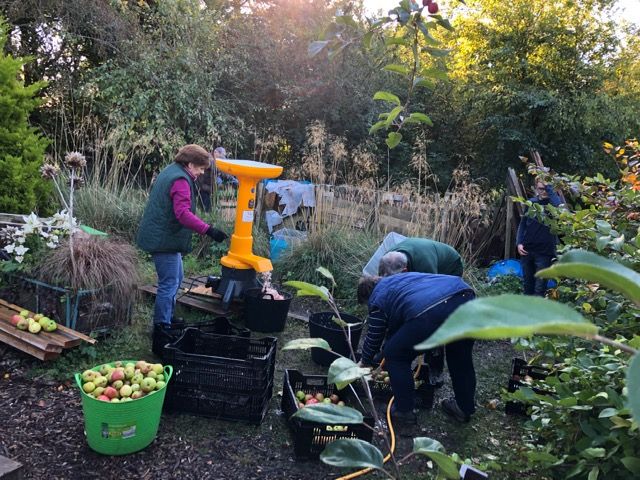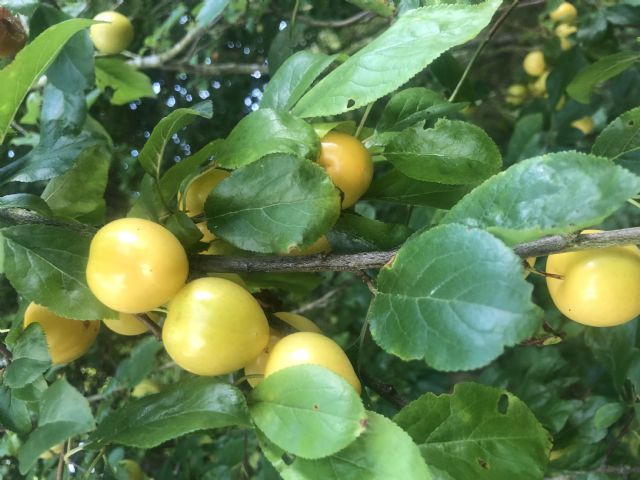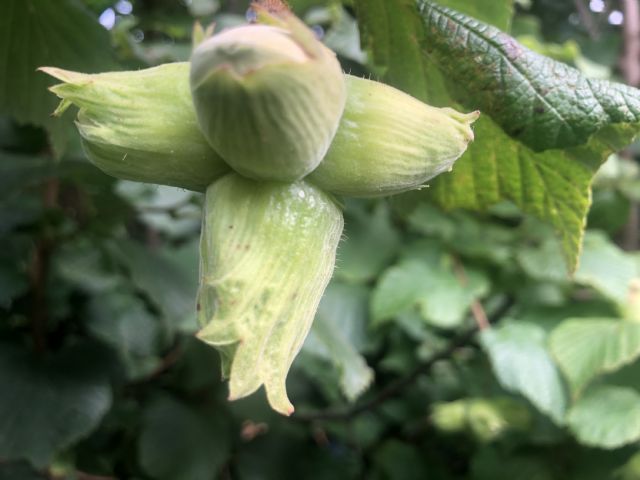Community Orchard

STRATHKINNESS COMMUNITY ORCHARD SOFT FRUIT CAGE AND FRUIT IN THE NO DIG BEDS |
ORCHARD NOTES
1. The garden as a whole including the orchard is on a gentle south facing slope, ideal for the cultivation of both fruit and vegetables. The bottom of the orchard is much wetter and more poorly drained than the top. Some of the plum trees originally planted towards the bottom died and subsequent planting of plums damsons and gages has been towards the top.
2. We have several Scottish Heritage varieties of apples and plums which are all doing well. Some, like Bloody Ploughman are very vigorous with upright growth and need to be pruned/ trained carefully in order to control this apical dominance. Our oldest heritage tree dates back to 1629, the Jardonelle pear of unknown origin.
3. The apples have many uses. Here is a summary of what we have found over the last few years: 3.1 The best early eaters according to a Strathkinness children are - Katy and Discovery. Other early eaters are James Grieves, Early Worcester, Fortune, and Hood’s Supreme. 3.2 Good late eaters that tend to be the best storing apples are - Hawthornden, Beauty of Moray, Elstar, Monarch, Lord Derby, Ribston Pippin, Rosemary Russet, Blenheim Orange, Fiesta, Sunset, and Fortune. 3.3 Cooking apples are - Scotch Bridgett, Arthur Turner, Hawthornden, Beauty of Moray, Tower of Glamis, Bramley’s Seedling, Lord Derby, and Howgate Wonder. Note all these cooking apples become excellent eaters from October onwards and are excellent storers. 3.4 We produce large quantities of apple juice each year and Villagers bring containers along. We use a mixture of apples including those from any tree that are blemished and some that have been found to have tough skins ( our orchard is organic). The following apples are predominately used for juicing: Falstaff, Red Falstaff, and all unlabelled trees including the one in the School Garden.
4. In the orchard layout sheet we show the name of the tree, the year it was introduced, the country of origin, the pollination group, the fruiting habit spur or tip that determines pruning, whether cooker eater or dual, if it stores. Most trees are labelled and give the year planted.
5. Apple trees are mainly trained as low bushes with open centres and have the semi dwarfing M26 rootstock. Some such as Beauty of Moray are Spindle trained on tall stakes with branches festooned ( only in Summer when sap has risen) in early years for maximum yields as in commercial orchards.
6. Plums are grown as bushes or pyramids using the tied down festooning technique used to encourage early fruiting I.e. blossom production before upward growth. This was a technique much used by Fife’s greatest fruit grower, the late Willie Duncan.
7. The trees are colour coded to help decide how and when to prune. Green - all stone fruit such as plums damsons and gages only pruned from May to September. White - all trees that have a tip bearing tendency, mainly winter pruned but the spindles have some Summer pruning. Red - all trees are spur bearing and winter pruned.
|
THE SOFT FRUIT GARDEN
This is housed in a full height walk in cage erected in 2012 using funding kindly provided by St. Andrews Community Trust. It provides protection from the garden birds that also love soft fruit and is used by members eaten fresh from the trees and bushes and also made into jam for sale at our Open Days. In the garden we have the following fruit: Summer fruiting raspberries, cordon red currants, bush redcurrants, blueberries, saskatoons, Morello cherries and sweet cherries. Cherries do particularly well in Fife but must have the protection of netting. The roof of the cage is removed in Winter to prevent snow damage. We have grown strawberries but like to use the full height of the cage for the other fruit. We found that Autumn raspberries, gooseberries, Worcester berries, blackcurrants and brambles are not so attractive to birds, and these are grown in other parts of the garden as shown on the No Dig Garden plan. Gooseberries and blackcurrants are best grown as vertical cordons for ease of picking. |
OTHER FRUIT AND TRAINING FORMS
Fruit growing is not confined to the areas so far described. In the polytunnel we have a fan trained Brown Turkey fig and a multiple cordon trained red grape vine. On the west wall of Iain’s shed there is a Tomcat apricot fan trained and planted in 2022. In the upper part of the garden surrounding allotment plots there are apple trees trained as cordons, espaliers, and step overs. |
THE HABITAT/ FORAGING/FOREST GARDEN AREA
In 2010 when we first started the Community Garden we decided to encourage wildlife by keeping the grass and vegetation high and planted a collection of wild trees and bushes that included hazel, elder, wild cherry plum, blackthorn, crab apple, Rosa rugosa along with coppiced willows of different colours and soft fruit bushes in the adjacent shrub border. We also planted Spring bulbs donated by members. The habitat planting has grown prolifically and fruited well each year with plenty of nuts, wild plums, and sloes to be foraged while leaving plenty for the wildlife that includes foxes, roe deer, badgers, squirrels, rabbits, hares and many garden birds. We have recently added some more hazel and different trees such as apple, mulberry and Cornus Mas along with some easily cared for herbaceous plants to make the area into what may be called a “Forest Garden”. We have also added a small open seated area that is pleasant for relaxation. |
 cherry plums ready for harvesting |
 hazel nuts ready for harvesting |
Here is the orchard plan for trees first planted in 2011. Each tree has an individual label to help identification along with this chart positioned at the bottom of the orchard.
Apple unknown From Gill’s |
Damson Merryweather 1900 England Gp.3 cook |
Pear Jardonelle 1629 August tip Gp. 3 no store unknown origin |
Apple Scotch Bridget 1850 Scotland spur gp. 3 cook/store |
Quince Serbian Gold spur juice Plum Mirabelle France cook/eat |
Plum Victoria 1840 England Sept. Gp.3 |
X unknown Apple X Apple |
|||
Apple Arthur Turner 1900 England Oct. Gp.3 spur cook |
Apple no store Hawthornden 1780 Scotland Sept. gp.3 dual |
Apple Beauty of Moray 1883 Scotland Sept g.3 Spur cook store |
Apple Tower of Glamis 1800 Scotland Nov. g2 Spur cook store |
Apple Johnagold USA 1953 triploid |
Plum Lizzie July |
Plum Old Greengage 1550 France Aug. G.3 |
|||
Apple Elstar 1972 Holland gp.3 spur Nov |
Apple Monarch 1888 England Gp.3 spur dual |
Apple Bramley 1809 England Nov triploid cook |
Apple Bloody Ploughman 1883 Scotland gp. 4 spur dual store |
JUICE |
Apple James Grieve 1893 Scot Sept. G.3 spur eat store |
Apple James Grieve |
Plum No name |
Apple Lord Derby 1850 England Oct. g.4 Spur dual store |
EARLY EATER |
Apple Howgate 1915 Eng.Nov. G.3 spur cook store |
Apple Howgate |
Apple Ribston Pippin 1700 England Oct. g.3 Spur eat store |
Apple Ribston Pippin |
COOKER LATE EATER STORE |
Apple Discovery 1949 Eng. Aug. G.3 tip eat |
Apple Discovery |
Apple Discovery |
Apple Discovery |
|
Apple Katy 1947 Sweden Aug. G.3 Spur eat no store |
Plum Czar 1874 England |
Apple Rosemary Russet 1831 England g.3 Spur eat store |
Apple Blenheim Orange1740 England Oct g.4 Tip dual store |
|
Apple Early Worcester 1945 Aug. G.4 tip eat |
Apple Fiesta 1972 Eng.Oct g.4 Spur eat store |
Apple Sunset 1918 Eng.Oct. g.3 Spur eat no store |
Apple Falstaff 1965 Eng.Oct. g.3 Spur eat store |
Pear Conference 1888 Eng. Oct. g.3 spur/tip |
Apple Red g.3 Falstaff 1886 Spur eat store |
Apple Fortune 1904 Eng. Sept. g.3 spur eat no store |
Apple Worcester 1874 Eng.Sept G.3 tip eat No store |
Apple unknown |
Plum Burnett Rare no info. |
Pear Sensation 1900 Australia Aug. G.4 spur |
Apple Hood’s Supreme 1924 Edzell Miss BY Hood related Iain Duncan |
Plum Gordon Castle 1864 Scotland Sept Eat no store |
Apple unknown From Gill’s |
